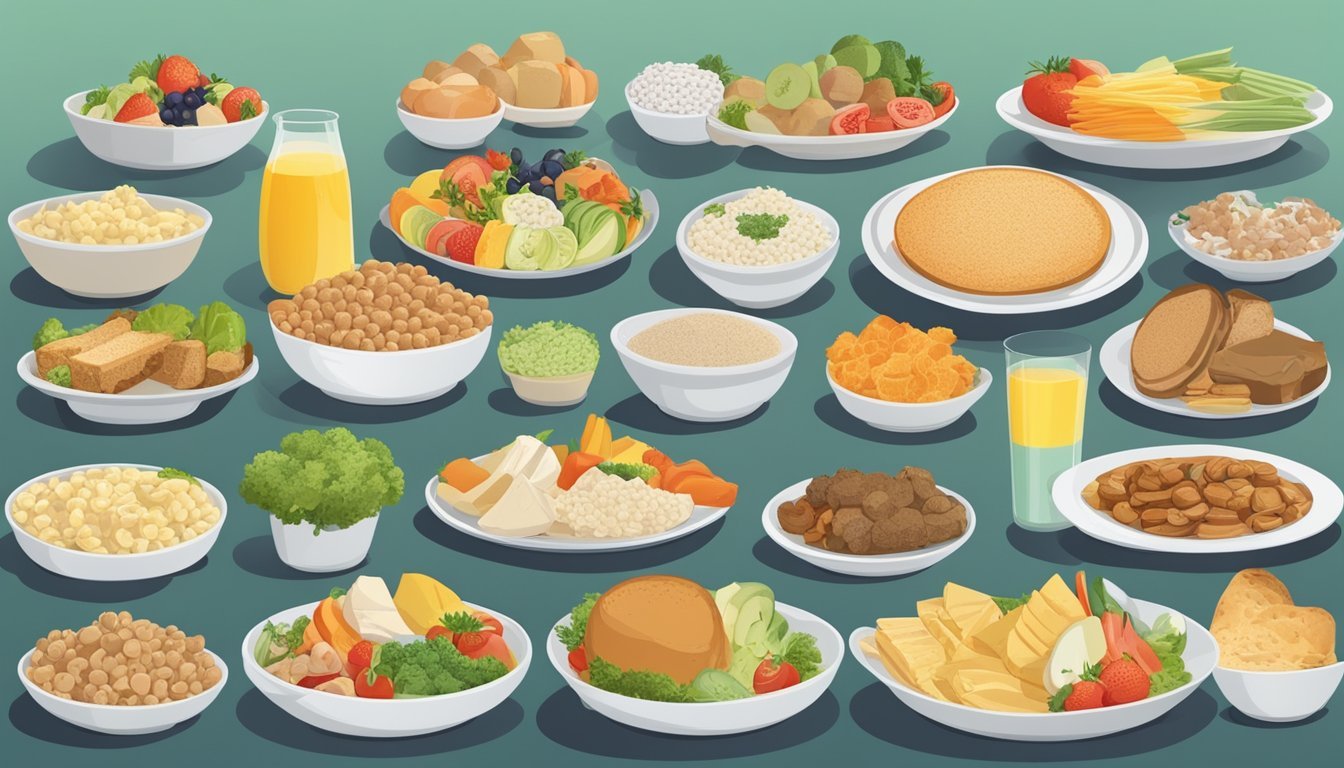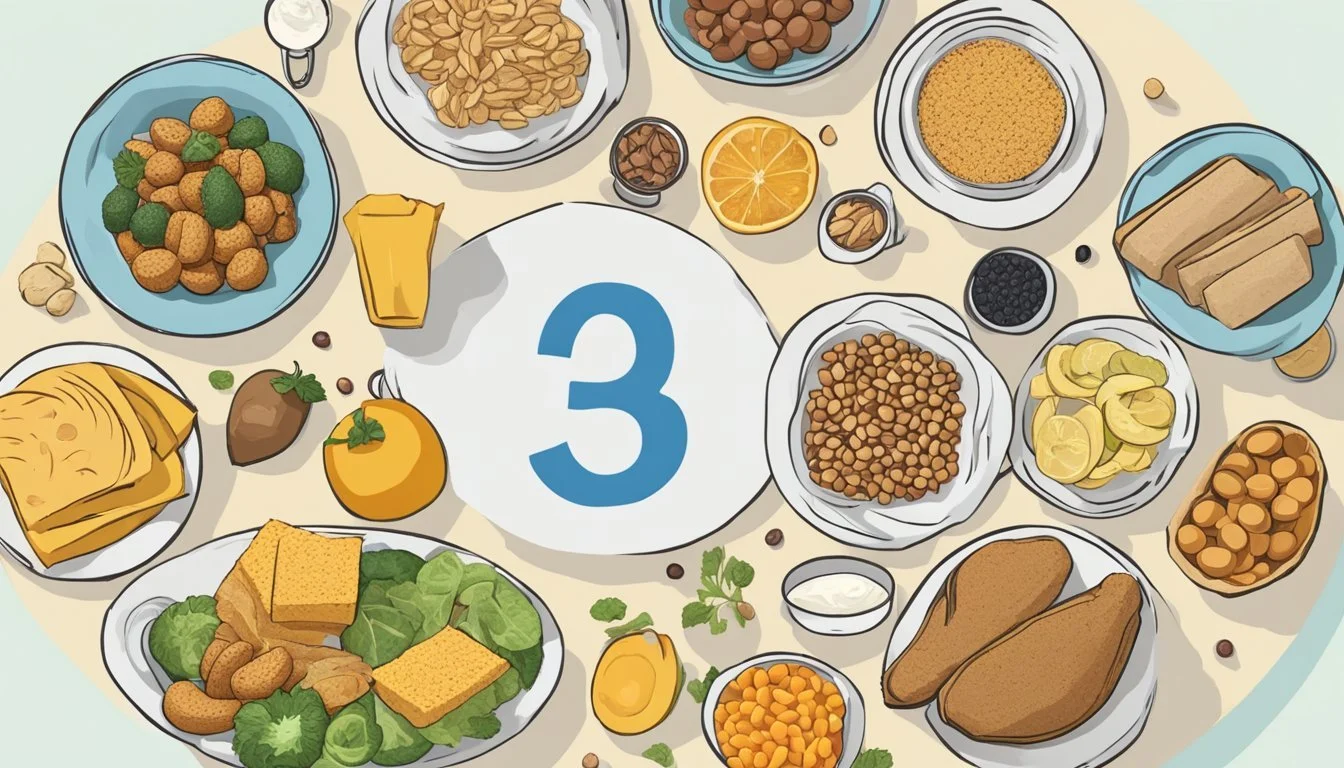How Many Servings of Sugar is Too Much
Expert Guidelines and Health Risks
Eating the right amount of fruits and vegetables each day is crucial for maintaining good health. Nutrition experts recommend consuming at least five servings of fruits and vegetables daily to reduce the risks of various health conditions and promote overall well-being. Two servings of fruit and three servings of vegetables are generally appropriate for an average adult.
While fruit is nutritious and provides essential vitamins and minerals, it's important not to overconsume it. In general, consuming more than two servings of fruit daily may lead to an intake of sugar that exceeds dietary recommendations, especially for those with certain health conditions. This highlights the necessity of balancing fruit intake with a variety of vegetables to optimize health benefits.
People need to understand what constitutes a serving to manage their diet effectively. Common examples of a single serving include one medium-sized fruit like an apple or a half-cup of chopped vegetables. Adding variety within these servings can ensure a comprehensive intake of nutrients, supporting an overall healthy diet.
Understanding Servings
Understanding what constitutes a serving and how it impacts your dietary choices is essential for maintaining a balanced diet. It helps manage portion control and ensures you meet your nutritional needs without overconsumption.
What Constitutes a Serving?
A serving size is a standardized measurement of food, defined by guidelines like those from the USDA. For example, one serving of vegetables is typically about one cup of raw or cooked vegetables or 2 cups of leafy greens.
For fruits, a serving could be one medium whole fruit or ½ cup of chopped fruit. These standards help individuals compare nutritional content across different foods and make informed choices.
Understanding serving sizes also aids in controlling portion sizes on your plate. If a food label indicates that one serving is 150 calories, consuming two servings would double the caloric intake to 300 calories. This awareness can prevent overeating and support weight management efforts.
Sources like the American Heart Association underscore the difference between serving sizes and portions, emphasizing that portions can be larger or smaller than the recommended serving size. Practicing mindful eating by learning serving sizes is a step towards a healthier lifestyle.
Nutritional Requirements
Balanced daily nutrition is crucial for maintaining health and preventing chronic diseases. This section outlines specific daily recommendations and the importance of nutrient diversity to meet dietary needs.
Daily Recommendations
Daily nutritional requirements vary by age, sex, and activity level. For an average adult, a balanced diet should include approximately 2,000 to 2,500 calories. Essential nutrients must be incorporated to meet dietary needs.
Fruits and vegetables: Aim for at least five servings per day. These provide vital nutrients like fiber, vitamin C, and potassium.
Proteins: Include lean meats, fish, legumes, and nuts. They are necessary for muscle repair and overall health.
Carbohydrates: Focus on whole grains, which supply fiber and energy.
Fats: Opt for healthy fats from sources like avocados, nuts, and olive oil.
Water: Stay hydrated, aiming for eight 8-ounce glasses a day.
Nutrient Diversity
A diverse diet ensures intake of various vitamins, minerals, and antioxidants which are crucial for optimal health.
Fruits and vegetables: Different colors offer specific nutrients. For example, oranges and strawberries are rich in vitamin C, while bananas provide plenty of potassium.
Whole grains: Diversify your grain intake to include items like brown rice, quinoa, and oats. These grains are high in fiber and B vitamins.
Protein sources: Mix your protein sources to include both animal and plant-based options. Beans and lentils provide protein as well as fiber and essential minerals.
Eating a variety of nutrient-rich foods helps prevent deficiencies and supports overall well-being.
A balanced and varied diet, structured around these daily recommendations and nutrient diversity, is key to long-term health.
Health Benefits of Fruits and Vegetables
Fruits and vegetables offer numerous health benefits, including protecting against heart disease, reducing the risk of certain cancers, and aiding in weight management. Their rich content of fiber, antioxidants, and essential nutrients make them vital for maintaining good health.
Cardiovascular Health
Consuming fruits and vegetables has a profound impact on cardiovascular health. Studies indicate that individuals who eat around five servings per day are significantly less likely to suffer from heart disease. This is primarily due to the fiber, vitamins, and antioxidants present in produce.
Fiber helps to lower cholesterol levels, which reduces the risk of heart disease. Specific fruits and vegetables like berries, oranges, and leafy greens are particularly beneficial due to their high nutrient content.
Antioxidants such as vitamins C and E help to prevent the oxidation of cholesterol, which can form plaque in the arteries. This reduces the risk of atherosclerosis and other heart-related conditions.
Cancer Prevention
Fruits and vegetables play a vital role in lowering the risk of certain types of cancer. They are rich in antioxidants and phytochemicals, which protect cells from damage. Including a variety of colorful produce in the diet ensures a broad range of protective compounds.
Cruciferous vegetables like broccoli, cauliflower, and Brussels sprouts contain sulforaphane, which has been shown to inhibit the growth of cancer cells. Tomatoes are rich in lycopene, a powerful antioxidant linked to a reduced risk of prostate cancer.
Diets high in fruits and vegetables often correlate with a reduced risk of digestive cancers, including those of the stomach and colon.
Weight Management
Eating fruits and vegetables can aid in weight management due to their high fiber content and low-calorie nature. They provide a feeling of fullness without contributing to excessive calorie intake, which can help prevent weight gain.
Fiber in produce slows down digestion, which helps maintain a steady blood sugar level and reduces hunger pangs. Apples, bananas, and carrots are examples of high-fiber foods that can help in feeling full longer.
Additionally, the water content in many fruits and vegetables adds volume to the diet, further promoting satiety. Regular consumption of fruits and vegetables can contribute to a healthier weight and better overall health.
Potential Risks of Overconsumption
Consuming too much of certain foods can lead to a variety of health issues, from diabetes to digestive problems. Understanding these risks can help in making informed dietary choices.
Sugar Content and Diabetes
High sugar intake, whether from natural sources like fruit or processed foods, can increase the risk of type 2 diabetes. Excessive sugar can lead to insulin resistance over time.
Fruits, although healthy, contain fructose. Eating too many high-sugar fruits like grapes or cherries can contribute to elevated blood sugar levels. Managing portion sizes and balancing fruit with other food groups is essential to mitigate these risks.
Caloric Intake and Weight Gain
Overeating can lead to calorie surplus, which is a primary cause of weight gain and obesity. Foods high in calories but low in other nutrients, such as refined carbs and sugary snacks, are particularly problematic.
Even healthy foods must be consumed in moderation. For instance, corn and cherries, despite their nutritional benefits, can add up in calories if eaten in large quantities. Monitoring portion sizes is key to avoiding unnecessary weight gain.
Digestive Concerns
Overconsumption of fiber-rich foods can cause digestive issues such as bloating, gas, and constipation. Fruits and vegetables are typically high in fiber, and while they're essential for digestive health, too much can overwhelm the digestive system.
Eating large amounts of cherries might lead to stomach upset due to their naturally high fiber content. Similarly, excessive intake of corn can result in digestive discomfort. Balancing fiber intake with adequate hydration can help mitigate these effects.
Effective dietary planning involves considering both the benefits and the potential risks of overconsumption. Making informed choices ensures a balanced and healthy diet.
Proper Serving Sizes and Variations
Serving sizes for fruits can vary significantly depending on their form. Understanding the correct serving sizes for whole fruits, fruit juice, and different preservation methods is crucial for maintaining a healthy diet.
Whole Fruits Versus Fruit Juice
Whole fruits are generally recommended over fruit juices due to their higher fiber content. A single serving of whole fruit often provides more fiber and less sugar compared to an equivalent serving of fruit juice.
For example, one medium apple or banana typically counts as one serving. In contrast, just 4-6 ounces of 100% fruit juice is considered a serving but lacks the fiber found in whole fruits.
Fruit juices, even those without added sugars, tend to have higher sugar content and can contribute to calorie intake more quickly. Monitoring portions and prioritizing whole fruits are essential for balancing vitamins and sugar intake effectively.
Fresh, Frozen, and Dried Fruits
Despite their differences in preservation, fresh, frozen, and dried fruits can all be part of a healthy diet if consumed in appropriate servings.
Fresh Fruits: Usually, one medium-sized piece counts as a serving. They are often preferred for their natural taste and nutrient content.
Frozen Fruits: These can be a convenient and nutritious option. Ensure no added sugars or preservatives. Small portions like 1 cup of frozen berries equate to one serving.
Dried Fruits: Concentrated in sugars and calories, dried fruits such as raisins or dried apricots should be consumed in smaller amounts. Roughly ¼ cup of dried fruit is equivalent to one serving of fresh fruit.
Including any of these forms of fruits can provide essential vitamins, but paying attention to portion sizes helps manage sugar content and calorie intake.
Dietary Integration
Integrating servings of various foods into daily meals requires balancing nutrition while incorporating a diverse range of food items. Effective dietary integration ensures a balanced intake of nutrients and promotes overall health.
Balancing Meals and Snacks
Balancing meals and snacks is crucial for maintaining a healthy diet. A well-rounded breakfast might include a serving of fruit with cereal or yogurt. Lunch should feature varied servings such as vegetables in a salad or sandwiches.
Dinner can include proteins like chicken or tofu paired with vegetables. Snacks in between meals, such as an apple or a handful of nuts, contribute additional servings and help control hunger. Drinking water aids digestion and hydration throughout the day.
Incorporating Variety
Variety in the diet ensures the intake of a full spectrum of nutrients. Incorporate different fruits and vegetables across meals. Breakfast could include a mix of berries with yogurt. Lunch might feature a colorful salad with proteins like beans or grilled chicken.
Dinner can alternate between different vegetables and protein sources. Including diverse food groups prevents dietary monotony and boosts nutrition. Varying desserts such as fruit salads also add nutritional value without excessive calories or sugars. By regularly rotating food choices, meal plans remain interesting and nutritious.
Special Considerations
When determining the appropriate number of servings per day, individual needs vary significantly based on age and health conditions. It's essential to tailor recommendations for specific groups to ensure healthy and balanced diets.
Children and the Elderly
Children and the elderly require special attention regarding their dietary needs. Children, depending on their age, may need fewer servings but require nutrient-dense foods to support growth and development. For instance, they need adequate vitamins, minerals, and folate. Consuming fruits like apples and bananas can help meet these needs.
Conversely, elderly individuals often have decreased metabolic rates and may need fewer calories. However, they should focus on nutrient-rich foods to prevent deficiencies. Foods rich in vitamins and that can help with issues like lowering blood pressure are crucial. Tailoring servings from fruits such as berries can provide necessary antioxidants and vitamins.
Health Conditions and Allergies
People with specific health conditions or allergies must be careful about their daily servings. For individuals with diabetes, monitoring table sugar and added sugars is essential. Fruits such as bananas should be eaten in moderation due to their higher natural sugar content.
For those with food allergies, it is important to avoid trigger foods and substitute with safe alternatives. For example, individuals with berry allergies can opt for other fruits rich in similar nutrients and vitamins.
Chronic conditions like hypertension require diets that can reduce inflammation and promote heart health. Food choices should focus on promoting overall well-being, such as incorporating servings known for lowering blood pressure.
By paying close attention to these factors, specific groups can manage their servings effectively.
Practical Advice for Daily Intake
To maintain a balanced diet, one should aim for consuming five servings of vegetables per day while paying close attention to portion sizes and preparation methods. It’s crucial to incorporate various types of vegetables to ensure a wide range of nutrients.
Food Preparation and Cooking Tips
When preparing vegetables like spinach, broccoli, cauliflower, and carrots, it's best to opt for steaming, grilling, or roasting instead of frying. These methods help retain their nutrients without adding unnecessary calories.
For leafy greens such as kale and spinach, a quick sauté with a small amount of olive oil can enhance flavor without excessive calories.
Portion Reminder:
Spinach, Broccoli, Cauliflower: One serving equals 1 cup of raw or 1/2 cup cooked.
Carrots: One serving equals 1/2 cup cooked or raw.
Additionally, making use of spices and herbs can elevate the taste without adding fats or sugars. Tomatoes, peppers, and onions are excellent for creating a flavorful base for many dishes, while squash and avocado can add texture and nutritional value.
Monitoring Intake
Monitoring daily intake of vegetables can be achieved through mindful portion control and measuring servings accurately. Aim for a mix of raw and cooked vegetables to diversify nutrient intake.
Daily Distribution:
Breakfast: Add spinach or tomatoes to omelets.
Lunch: Include a side of broccoli or a mixed greens salad.
Dinner: Add roasted peppers, onions, or squash to main dishes.
Using a food diary or a mobile app can help track servings of vegetables consumed throughout the day.
This method is especially effective for ensuring variety, helping include nutrient-dense vegetables like kale, peas, and potatoes in the diet.
Be wary of overconsumption of starchy vegetables like potatoes, as they can contribute to high calorie intake if portions are not controlled.
Conclusion
Finding the ideal amount of servings for various foods is crucial for maintaining a balanced diet.
For staple foods like rice and potatoes, moderation is key. A practical guideline is to limit rice to half a cup per serving and consider the nutritional content of potatoes in a 100-gram serving.
Vegetables play an important role in a balanced diet. For example, corn can be consumed in quantities up to 3-4 cups per day for men, depending on dietary needs.
Using the 1-2-3 approach for fruits and vegetables, which involves 1 serving with breakfast, 2 with lunch, and 3 with dinner and snacks, ensures a diverse intake of nutrients.
Standard serving sizes include:
Rice: ½ cup cooked
Potatoes: 100 grams
Corn: 2-4 cups
Fruits & Vegetables: 4-6 ounces per serving
It's critical to tailor these recommendations to individual dietary requirements. Adjusting servings helps maintain a healthy and balanced diet.
Incorporating a variety of foods in correct servings supports intake of essential nutrients and helps avoid the pitfalls of excessive consumption.








